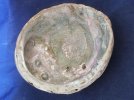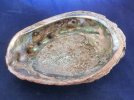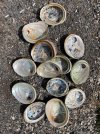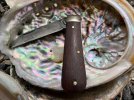I've processed a lot of abalone. My brother was an abalone diver in CA many years back. I still have a box of uncut shells somewhere in the shop.
The first thing I want to say is the things you read online about it being deadly toxic or having cyanide is false. No dust is good to breathe so wear a face mask or a respirator, but abalone is just shell - calcium carbonate and other organics. It makes a lot of fine dust, so have a vacuum running with the nozzle right at the sawblade or belt sander. Vacuum up all the dust off you and the work area when done.
Cut it with normal tools. I use my metal cutting bandsaw. You can use a coping saw with a metal blade or a hacksaw. Sand it with any normal abrasive that works on wood or metal. However, if a tile cutting "wet" diamond saw is available, by all means us that to cut the shells.
As Bill said, cutting a slab of abalone will only get a small piece of usable material. It would great for inlay and small scales on folders, but a large colorful piece is rare.
When working it you have to decide when to stop grinding. Going "just a little deeper" can go right through the color and give you only dull shell.
When cutting the shells, start by slicing the shell into the longest strips you can. Usually, you get one or two strips. Lightly sand the surfaces and see what it looks like. As you flatten the pieces, pick the side that seems it will have the best color. Surprisingly, it may not always be the inside. Dipping in water or using a water mist helps a lot with keeping the dust down. I suggest doing it outside or having a vacuum running right where you are sanding/cutting.
Once the pieces are flattened down mark where the best color is and go from there in cutting the scales you need. Polishing is just sanding to around 800 grit and buffing with matchless white.
DON'T let it get HOT!
Sometimes, a better use is to make a decorative stand or an ornament from the shell. Sand and polish the outer surface until it looks beautiful and use it to display a knife on at a show or as a windowsill or table decoration in the house. I have also seen them made into candlesticks by attaching a candle holder on the top. The alternative is to make your own composite scales. It can be done by fitting a mosaic of many colorful smaller pieces on a thin piece of G-10 and grinding them down. With the trend for casting resins, you can also crush the colorful stuff and cast a resin blank to use for handle scales.
These posts threads have more info you should read:
I have two Abalone shells that I would like to use for handle scales. I know that when cutting Abalone shells some very dangerous dust is generated and the proper precautions must be taken. Does anyone have any suggestions on what cutting tools or techniques should be used ? Any helpful hints would be appreciated on how to go about preparing scales from Abalone.
Thanks
Tim


so im over my gradpas house the other day and he has literly hundreds of these from his diving days. the insides are very nice color wise from deep blue to purple and various other colors. So im looking at these and going hmm wonder if i can incorperate some of the nice parts of the shell into a knife handle. My question is can this be done? and how would i go about doing it. most pieces are round obviously but i notice the lip part has about 1/4 flat on it. I was thinking maybe i could inlay part of a handle with this or maybe make some kinda spacer out of it. Any1 ever work with this...
I brought some shells back from Mexico with the intention of making some scales and maybe some inlay pieces with the leftovers.
I have searched the forum and read all I could find. I am aware of the safety hazards and the need to cut/grind slow and wet. Does anyone have any tips to offer on layout and flattening? I was thinking of using an epoxy or resin paste to fill the concave side for better thickness / size possibilites - much like is often done on mammoth bark scales. There is some beautiful ridge pattern on the polished exterior side.
It's pretty stuff and I'd hate to screw...






